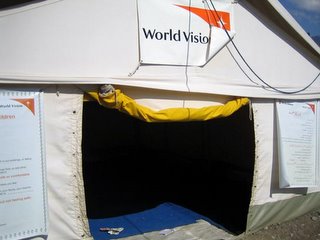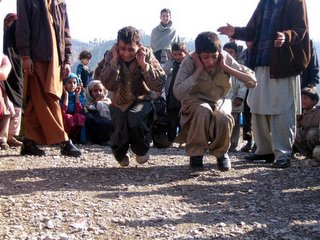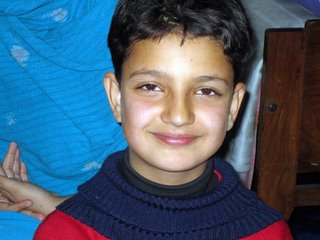Day 5: A TRIP TO WORLD VISION'S CHILD FRIENDLY SPACES
Posted in Pakistan on Monday, January 23, 2006
By Katie Roland, Metro Marketing
& Communications Director for New York
Posted in Pakistan on Monday, January 23, 2006
By Katie Roland, Metro Marketing
& Communications Director for New York
“And the streets of the city shall be full of boys and girls playing in the streets” (Zechariah 8:5).
It is an awesome thing to stand in the middle of utter destruction and hear the joyous sounds of children laughing and playing together. World Vision’s Child Friendly Spaces provide a first step to recovery for hundreds of Pakistani children who are still traumatized by the horror of the quake. Continued below.

Katie plays with children at the Child Friendly Space in Ghari Habibullah.

World Vision's Child Friendly Space in Gharhi Habibullah, a town near Balakot.

Two boys play “the rabbit game” at World Vision’s Child Friendly Space in Gharhi Babibullah.

Nimra, a young girl from the village of Gharhi Habibullah, attends World Vision's Child Friendly Space programs after the earthquake.
Today, I met a young girl named Nimra, a nine-year-old who was too scared to go to school until she attended World Vision Child Friendly Space in a town near Balakot. Child Friendly Spaces are a safe place for children to laugh, play and sing to overcome the trauma of the earthquake and return to a normal way of life. Though Nimra’s school was not damaged in the quake, 287 girls died in a school right next door.
Nimra had a beautiful smile and was very content and happy when we played with her. She was engaged in games like “duck, duck, goose” and “head, shoulders, knees, and toes” and interacted beautifully with the rest of the children. Her mother, Seemi, said that the staff at World Vision’s Child Friendly Space helped her regain the confidence she needed to return to school.
Nearly 50 children were playing alongside Nimra this morning. Throughout the earthquake zone, World Vision has established 15 Child Friendly Spaces, which care for more than 700 children daily during the week. World Vision’s long-term goal is to double that number, helping a total of 1,500 children heal and find hope in their futures.

3 comments:
We are praying for you, Katie and Amber!! Thank you for so willingly and faithfully serving our Lord by ministering to those in need. We niss you!
How are Child Friendly Centers most different from Child Daycares that we have here in the US?
Good question. Child Friendly Spaces (CFS) are different from daycares in two primary ways. First, the purpose of CFS is not to provide child care when parents are away from the home. Almost all of the children who attend World Visions CFS sites in Pakistan have mothers or other caretakers (aunts, grandmothers) waiting for them in their tent homes. Because the Pakistan CFS sites are in tent villages - camps of people who have been displaced because of the earthquake - the children at the CFS sites are often only a few hundred yards away from their temporary shelters.
Second, CFS sites are unlike daycares in that CFS sites are intentionally placed in communities where children have experienced a trauma (like the Pakistan earthquake, or the tsunami). World Vision believes it is important to help families physically recover from disasters; but it is also important that we care for the emotional well being of children. Child friendly spaces give children a chance to be kids: to play games, to laugh, to dance, to sing, to connect with gentle staff members who are good listeners. World Vision staff are also able to monitor children for evidence of unusual need: hunger, lack of winter clothing, abuse.
Here in Pakistan, I've had many mothers tell me that after the earthquake their children were afraid to leave their families and return to school. The October 8 quake happened just as the school day was beginning; 17,000 school children and 900 teachers were killed. For the children of this region of Pakistan, school is a place of difficult memories. It's easy to understand why they don't want to return.
Many mothers have also told me that the CFS sites in their communities helped children take the first step toward going back to school. They gathered with their friends, learned to laugh again, and rebuilt some of the self-confidence that was damaged during the earthquake.
You may have read the story of Arslan in one of our earlier blogs. Arslan lost both his parents in a landslide caused by the earthquake. His grandmother took him in, and because her home was destroyed they moved to a tent village where World Vision operates a CFS site.
Arslan's grandmother sent him to school and the CFS each day, but at first Arslan was withdrawn. He stood to the side, not interested in joining in the activities. Slowly, thanks to the gentle work of the CFS facilitators, Arslan began to join in the activities.
Though he is still a shy boy, he now actively plays with the other children and seems to be recovering from the trauma of the earthquake.
Post a Comment